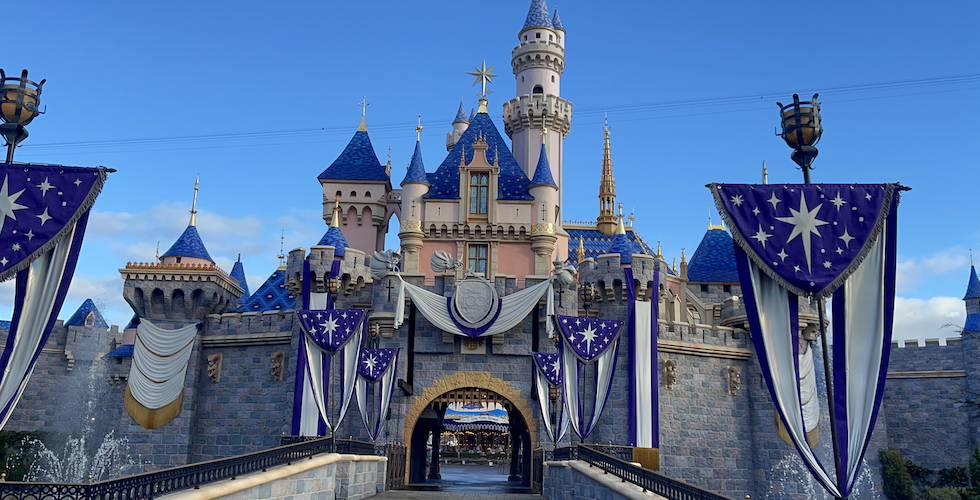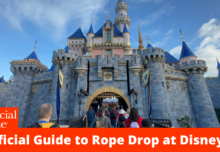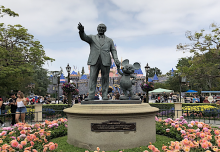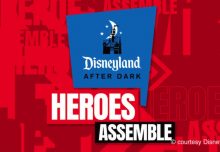Disneyland Park and Disney California Adventure (DCA) are family theme parks. Yet some of the Disney adventure rides can be intimidating to small children. On certain rides, such as Tiana’s Bayou Adventure and the roller coasters (Incredicoaster, Space Mountain, Matterhorn Bobsleds, and Big Thunder Mountain Railroad), the ride itself may be frightening. On other rides, such as Haunted Mansion and Pinocchio’s Daring Journey, it is the special effects.

We recommend a little parent-child dialogue coupled with a “testing the water” approach. A child who is frightened by Peter Pan’s Flight should not have to sit through Haunted Mansion. Likewise, if Big Thunder Mountain Railroad is too much, don’t try Space Mountain or the Incredicoaster.
Disney rides and shows are adventures. They focus on the substance and themes of all adventure and, indeed, of life itself: good and evil, beauty and the grotesque, fellowship and enmity, quest, and death. Though the endings are all happy, the impact of the adventures, with Disney’s gift for special effects, is often intimidating and occasionally frightening to small children.
There are rides with menacing witches, rides with burning towns, and rides with ghouls popping out of their graves, all done tongue-in-cheek and with a sense of humor, provided you are old enough to understand the joke. And there are bones, lots of bones—human bones, cattle bones, and whole skeletons are everywhere you look. There have to be more bones at Disneyland Park than at the Smithsonian and the School of Medicine at UCLA combined. Skeletal corpses lunge at riders on the Indiana Jones Adventure; a veritable platoon of skeletons sails ghost ships in Pirates of the Caribbean; a macabre assemblage of skulls and skeletons are in Haunted Mansion; and more skulls, skeletons, and bones punctuate Peter Pan’s Flight and Big Thunder Mountain Railroad.

The reaction of young children to the inevitable system overload of Disney parks should be anticipated. Be sensitive, alert, and prepared for almost anything, even behavior that is out of character for your child at home. Most small children take Disney’s variety of macabre trappings in stride, and others are quickly comforted by an arm around the shoulder or a little squeeze of the hand. For parents who have observed a tendency in their kids to become upset, we recommend taking it slowly and easily by sampling more benign adventures such as the Jungle Cruise, gauging reactions, and discussing with children how they feel about the things they see.
Sometimes, small children will rise above their anxiety in an effort to please their parents or siblings. This behavior, however, does not necessarily indicate a mastery of fear, much less enjoyment. If children come off of a ride in ostensibly good shape, we recommend asking if they would like to go on the ride again (not necessarily right now, but sometime). The response to this question will usually give you a clue as to how much they actually enjoyed the experience. There is a big difference between having a good time and mustering the courage to get through something.

Evaluating a child’s capacity to handle the visual and tactile effects of the Disney parks requires patience, understanding, and experimentation. Each of us, after all, has our own demons. If a child balks at or is frightened by a ride, respond constructively. Let your children know that lots of people, including adults, are scared by what they see and feel. Help them understand that it is OK if they get frightened. Take pains not to compound the discomfort by making a child feel inadequate; try not to undermine self-esteem, impugn courage, or subject a child to ridicule. Most of all, do not induce guilt, as if your child’s trepidation is ruining the family’s fun. When older siblings are present, it is sometimes necessary to restrain their taunting and teasing.
A visit to a Disney park is more than an outing or an adventure for a small child. It is a testing experience, a sort of controlled rite of passage. If you help your little one work through the challenges, the time can be immeasurably rewarding and a bonding experience for both of you.
The Fright Factor
While each youngster is different, there are essentially seven attraction elements that alone or combined can push a child’s buttons:
1. THE NAME OF THE ATTRACTION Small children will naturally be apprehensive about something called Haunted Mansion.

2. THE VISUAL IMPACT OF THE ATTRACTION FROM OUTSIDE Tiana’s Bayou Adventure, Guardians of the Galaxy—Mission: Breakout!, and Big Thunder Mountain Railroad look scary enough to give even adults second thoughts. To many small kids, the rides are visually terrifying.

3. THE VISUAL IMPACT OF THE INDOOR QUEUING AREA Pirates of the Caribbean, with its dark bayou scene, and Haunted Mansion, with its “stretch rooms,” are capable of frightening small children before they even board the ride.
4. THE INTENSITY OF THE ATTRACTION Some attractions are so intense as to be overwhelming; they inundate the senses with sights, sounds, movement, and even smell. Mickey’s PhilharMagic in DCA, for instance, combines loud music, tactile effects, lights, and 3-D cinematography to create a total sensory experience. For some preschoolers, this is two or three senses too many.
5. THE VISUAL IMPACT OF THE ATTRACTION ITSELF As previously discussed, the sights in various attractions range from falling boulders to lurking buzzards, from underwater volcanoes to attacking hippos. What one child calmly absorbs may scare the living daylights out of another child the same age.
6. DARK Many Disneyland attractions are dark rides—that is, they operate indoors in a dark environment. For some children, this fact alone is sufficient to trigger significant apprehension. A child who is frightened on one dark ride (for example, Pinocchio’s Daring Journey) may be unwilling to try other indoor rides.

7. THE RIDE ITSELF; THE PHYSICAL EXPERIENCE Some Disney rides are downright wild—wild enough to induce motion sickness, wrench backs, and generally discombobulate patrons of any age.

A Bit of Preparation
We receive many tips from parents relating how they prepared their children for the Disneyland experience. A common strategy is to acquaint kids with the characters and the stories behind the attractions by reading Disney books and watching Disney movies at home. You can view a clip of every attraction and show on youtube .com. Videos of dark rides aren’t stellar but are good enough to get a sense of what you’re in for.
Watch the full POV of the Goofy’s Sky School and the Grizzly River Run. Both rides are located at Disney California Adventure.
For all there is to see and do at Disneyland, check out The Unofficial Guide to Disneyland by Seth Kubersky with Bob Sehlinger, Len Testa, and Guy Selga Jr. All Disneyland fans should also check out The Disneyland Story: The Unofficial Guide to the Evolution of Walt Disney’s Dream by Sam Gennawey.
If you enjoyed this post, please subscribe to our YouTube channel and sign up for our newsletter here. Be sure to follow us on Twitter, Facebook, Instagram, Pinterest, and YouTube. #unofficialguide #theUGSeries





